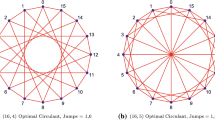Abstract
A two-dimensional (2D) Petersen-torus network is a mesh-class fixed-degree network designed using a Petersen graph, which has a maximum of 10 nodes when the degree is 3 and the diameter is 2 in a (d,k)-graph problem. Here, I propose a new three-dimensional (3D) Petersen-torus network that extends the 2D Petersen-torus network without increasing the degree. The 3D Petersen-torus has the same number of nodes (N). The 3D Petersen-torus is better than the well-known 3D torus and 3D honeycomb mesh in terms of diameter and network cost. The 3D Petersen-torus network is better than the hypercube-like and star graph-like networks in terms of extendibility. Hence, the proposed network may serve as the foundation for realizing a high-performance multicomputer. In this paper, the optimal routing algorithm, Hamilton cycle, and several basic attributes are discussed. Furthermore, a comparison with a mesh-class fixed-degree 3D network is made for degree, diameter, and network cost.
Similar content being viewed by others
References
Ergu D, Kou G, Peng Y, Shi Y, Shi Y (2011) The analytic hierarchy process: Task scheduling and resource allocation in cloud computing environment. J Supercomput. doi:10.1007/s11227-011-0625-1
Parhami B, Kwai D-M (2001) A unified formulation of honeycomb and diamond networks. IEEE Trans Parallel Distrib Syst 12(1):74–80
Ni LM, McKinley PK (1993) A survey of wormhole routing techniques in direct networks. IEEE Comput 26(2):62–76
Parhami B, Rakov M (2005) Perfect difference networks and related interconnection structures for parallel and distributed systems. IEEE Trans Parallel Distrib Syst 16(8):714–724
Parhami B, Yeh C-H (2000) Why network diameter is still important. In: Proc int’l conf comm in computing, pp 271–274
Saad Y, Schultz MH (1988) Topological properties of hypercubes. IEEE Trans Comput 37(7):867–872
Mendia VE, Sarkar D (1992) Optimal broadcasting on the star graph. IEEE Trans Parallel Distrib Syst 3(4):389–396
Tang KW, Padubidri SA (1994) Diagonal and toroidal mesh networks. IEEE Trans Comput 43(7):815–826
Latifi S, Srimani PK (1998) A fixed degree regular networks for massively parallel systems. J Supercomput 12(3):277–291
Zhou S, Du N, Chen B (2006) A new family of interconnection networks of odd fixed degrees. J Parallel Distrib Comput 66(5):698–704
Moraveji R, Sarbazi-Azad H, Zomaya AY (2011) Performance modeling of Cartesian product networks. J Parallel Distrib Comput 71(1):105–113
Ghose K, Desai KR (1995) Hierarchical cubic network. IEEE Trans Parallel Distrib Syst 6(4), 427–435
EI-Amawy A, Latifi S (1991) Properties and performances of folded hypercubes. IEEE Trans Parallel Distrib Syst 2(1):31–42
Efe K (1991) A variation on the hypercube with lower diameter. IEEE Trans Comput 40(11):1312–1316
Park J-H (1992) Circulant graphs and their application to communication networks. PhD Thesis, Dept of Computer Science, KAIST, Taejon, Korea
Yeh C-H, Varvarigos E (1996) Macro-star networks: Efficient low-degree alternatives to star graphs for large-scale parallel architectures. In: Frontier’96, symp on the frontiers of massively parallel computation
Latifi S, Srimani PK (1996) Transposition networks as a class of fault-tolerant robust networks. IEEE Trans Comput 45(2):230–238
Lee HO, Kim JS, Park KW, Seo JH (2005) Matrix star graphs: A new interconnection network based on matrix operations. In: ACSAC 2005. LNCS, vol 3740, pp 478–487
Stojmenovic I (1997) Honeycomb network: Topological properties and commnication algorithms. IEEE Trans Parallel Distrib Syst 8(10):1036–1042
Chen MS, Shin KG (1990) Addressing, routing, and broadcasting in hexagonal mesh multiprocessors. IEEE Trans Comput 39(1):10–18
Decayeux C, Seme D (2005) 3D hexagonal network: Modeling, topological properties, addressing scheme, and optimal routing algorithm. IEEE Trans Parallel Distrib Syst 16(9):875–884
Scott SL, Thorson G (1996) The Cray T3E network: Adaptive routing in a high performance 3D toms. In: HOT interconnects IV, Stanford University
Carle J, Myoupo JF, Stojmenovic I (2001) Higher dimensional honeycomb networks. J Interconnect Netw 2(4):391–420
Nguyen J, Pezaris J, Pratt GA, Ward S (1994) Three-dimensional network topologies. In: Proceedings of the first international workshop on parallel computer routing and communication, pp 101–115
Cray Inc (2008) Cray XT3 datasheet. http://www.cray.com/downloads/Cray_XT3_Datasheet.pdf
Cray Inc (2008) Cray XT4 datasheet. http://www.cray.com/downloads/Cray_XT4_Datasheet.pdf
Choo H, Yoo S-M, Youn HY (2000) Processor scheduling and allocation for 3d torus multicomputer systems. IEEE Trans Parallel Distrib Syst 11(5):475–484
Seo JH, Lee HO, Jang MS (2008) Petersen-torus networks for multicomputer systems. In: Proc int’l conf of NCM2008, vol 1, pp 567–571
Seo JH, Lee HO (2009) One-to-one embedding between hyper Petersen and Petersen-torus networks. Int J Grid Distrib Comput 2(4):27–33
Seo JH, Lee HO, Jang MS (2008) Node mapping algorithm between torus and Petersen-torus networks. In: Proc int’l conf of NCM2008, vol 2, pp 540–544
Seo J-H, Lee H-O (2009) One-to-all broadcasting in Petersen-torus networks for SLA and MLA models. ETRI J 31(3):327–329
Chartrand G, Wilson RJ (1985) The Petersen graph. In: Harary F, Maybee JS (eds) Graphs and applications, pp 69–100
Camara JM, Moreto M, Vallejo E, Beivide R, Miguel-Alonso J, Martínez C, Navaridas J (2010) Twisted torus topologies for enhanced interconnection networks. IEEE Trans Parallel Distrib Syst 21(12):1765–1778
Author information
Authors and Affiliations
Corresponding author
Rights and permissions
About this article
Cite this article
Seo, Jh. Three-dimensional Petersen-torus network: a fixed-degree network for massively parallel computers. J Supercomput 64, 987–1007 (2013). https://doi.org/10.1007/s11227-011-0716-z
Published:
Issue Date:
DOI: https://doi.org/10.1007/s11227-011-0716-z




